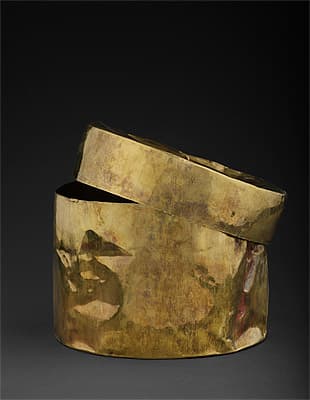
SICÁN-LAMBAYEQUE culture North coast 750 – 1375 AD
Container for cinnabar powder 750-1375 AD gold and cinnabar17.4 (h) cm 18.0 cm (diameter) Museo Oro del Perú, Lima Photograph: Daniel Giannoni
Red cinnabar (mercuric sulphide) was mined by many ancient Peruvian cultures. The mineral is extremely toxic and miners were said to ‘shake and lose their senses’. Many cultures favoured cinnabar because of its distinctive colour and brilliance. It was used widely to decorate gold grave goods, in sacrificial rituals—perhaps to represent blood—and was also used as paint for ornamenting corpses. Cinnabar adorned warriors’ bodies, was a cosmetic for elite women and was made into tattoo ink.
Red cinnabar (mercuric sulphide) was mined by many ancient Peruvian cultures. The mineral is extremely toxic and miners were said to ‘shake and lose their senses’. Many cultures favoured cinnabar because of its distinctive colour and brilliance. It was used widely to decorate gold grave goods, in sacrificial rituals—perhaps to represent blood—and was also used as paint for ornamenting corpses. Cinnabar adorned warriors’ bodies, was a cosmetic for elite women and was made into tattoo ink.
Red cinnabar (mercuric sulphide) was mined by many ancient Peruvian cultures. The mineral is extremely toxic and miners were said to ‘shake and lose their senses’. Many cultures favoured cinnabar because of its distinctive colour and brilliance. It was used widely to decorate gold grave goods, in sacrificial rituals—perhaps to represent blood—and was also used as paint for ornamenting corpses. Cinnabar adorned warriors’ bodies, was a cosmetic for elite women and was made into tattoo ink.

